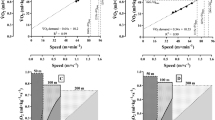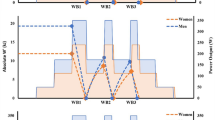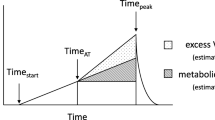Abstract
Purpose
This study aimed to verify the influence of chronological age on maximal accumulated oxygen deficit (MAOD) and the correlations with maximal oxygen uptake (VO2PEAK) and intensity (vVO2PEAK).
Methods
Thirty-one male athletes underwent an incremental exercise test involving 10 submaximal efforts (50–95% of velocity corresponding to VO2PEAK [vVO2PEAK]) and one supramaximal effort at 110% of vVO2PEAK to determine MAOD. We analyzed a combined group (n = 31) and two groups according to age (G1 = 15.5 ± 0.5; G2 = 36.0 ± 7.9 years).
Results
The values of absolute VO2PEAK (4.3 ± 0.4 L·min−1) and vVO2PEAK (15.9 ± 1.7 km·h−1) were higher in G2 than those in G1 (3.5 ± 0.3 L·min−1; 14.6 ± 0.9 km·h−1). Individuals in G1 had absolute and relative values of MAOD (2.4 ± 0.7 L; 35.1 ± 11.1 mL·kg−1) lower than those in G2 (3.9 ± 0.9 L; 46.8 ± 10.9 mL·kg−1). Correlations between MAOD and performance during the experimental protocol were tested; VO2PEAK and vVO2PEAK yielded correlations with performance (n = 31; r = 0.56; r = 0.60). Moreover, when corrected for chronological age, we detected correlations between absolute and relative values of MAOD and VO2PEAK (r = 0.42; r = 0.61) and vVO2PEAK (r = 0.43; r = 0.56).
Conclusions
The MAOD is influenced by chronological age and is related to VO2PEAK and vVO2PEAK independent of age.

Similar content being viewed by others
References
Gaitanos GC, Williams C, Boobis LH, Brooks S (1993) Human muscle metabolism during intermittent maximal exercise. J Appl Physiol (Bethesda, Md: 1985) 75(2):712–719. https://doi.org/10.1152/jappl.1993.75.2.712
Medbo JI, Mohn AC, Tabata I, Bahr R, Vaage O, Sejersted OM (1988) Anaerobic capacity determined by maximal accumulated O2 deficit. J Appl Physiol (Bethesda, Md: 1985) 64(1):50–60
Noordhof DA, de Koning JJ, Foster C (2010) The maximal accumulated oxygen deficit method: a valid and reliable measure of anaerobic capacity? Sports Med (Auckland, NZ) 40(4):285–302. https://doi.org/10.2165/11530390-000000000-00000
Hill DW, Vingren JL (2011) Maximal accumulated oxygen deficit in running and cycling. Appl Physiol Nutr Metab Physiologie appliquee nutrition et metabolisme 36(6):831–838. https://doi.org/10.1139/h11-108
Naughton GA, Carlson JS, Buttifant DC, Selig SE, Meldrum K, McKenna MJ, Snow RJ (1997) Accumulated oxygen deficit measurements during and after high-intensity exercise in trained male and female adolescents. Eur J Appl Physiol Occup Physiol 76(6):525–531. https://doi.org/10.1007/s004210050285
Weber CL, Schneider DA (2000) Maximal accumulated oxygen deficit expressed relative to the active muscle mass for cycling in untrained male and female subjects. Eur J Appl Physiol 82(4):255–261. https://doi.org/10.1007/s004210000214
Medbo JI, Burgers S (1990) Effect of training on the anaerobic capacity. Med Sci Sports Exerc 22(4):501–507
Pizza FX, Naglieri TA, Holtz RW, Mitchell JB, Starling RD, Phillips MD, Cavender DL, Braun WA (1996) Maximal accumulated oxygen deficit of resistance-trained men. Can J Appl Physiol Revue canadienne de physiologie appliquee 21(5):391–402
Weber CL, Schneider DA (2002) Increases in maximal accumulated oxygen deficit after high-intensity interval training are not gender dependent. J Appl Physiol (Bethesda Md: 1985) 92(5):1795–1801. https://doi.org/10.1152/japplphysiol.00546.2001
Doherty M (1998) The effects of caffeine on the maximal accumulated oxygen deficit and short-term running performance. Int J Sport Nutr 8(2):95–104
Bell DG, Jacobs I, Ellerington K (2001) Effect of caffeine and ephedrine ingestion on anaerobic exercise performance. Med Sci Sports Exerc 33(8):1399–1403
Jacobs I, Bleue S, Goodman J (1997) Creatine ingestion increases anaerobic capacity and maximum accumulated oxygen deficit. Can J Appl Physiol Revue canadienne de physiologie appliquee 22(3):231–243
Bangsbo J, Michalsik L, Petersen A (1993) Accumulated O2 deficit during intense exercise and muscle characteristics of elite athletes. Int J Sports Med 14(4):207–213. https://doi.org/10.1055/s-2007-1021165
Sloniger MA, Cureton KJ, Prior BM, Evans EM (1997) Anaerobic capacity and muscle activation during horizontal and uphill running. J Appl Physiol (Bethesda, Md: 1985) 83(1):262–269
Bertuzzi RC, Franchini E, Ugrinowitsch C, Kokubun E, Lima-Silva AE, Pires FO, Nakamura FY, Kiss MA (2010) Predicting MAOD using only a supramaximal exhaustive test. Int J Sports Med 31(7):477–481. https://doi.org/10.1055/s-0030-1253375
Andrade VL, Zagatto AM, Kalva-Filho CA, Mendes OC, Gobatto CA, Campos EZ, Papoti M (2015) Running-based anaerobic sprint test as a procedure to evaluate anaerobic power. Int J Sports Med 36(14):1156–1162. https://doi.org/10.1055/s-0035-1555935
Lacombe V, Hinchcliff KW, Geor RJ, Lauderdale MA (1999) Exercise that induces substantial muscle glycogen depletion impairs subsequent anaerobic capacity. Equine Vet J Suppl 30:293–297
Hill DW, Leiferman JA, Lynch NA, Dangelmaier BS, Burt SE (1998) Temporal specificity in adaptations to high-intensity exercise training. Med Sci Sports Exerc 30(3):450–455
Gastin PB (1994) Quantification of anaerobic capacity. Scand J Med Sci Sports 4:91–112
Doherty M, Smith PM, Schroder K (2000) Reproducibility of the maximum accumulated oxygen deficit and run time to exhaustion during short-distance running. J Sports Sci 18(5):331–338. https://doi.org/10.1080/026404100402395
Mezzani A, Corra U, Sassi B, Colombo R, Giordano A, Giannuzzi P (2006) Maximal accumulated oxygen deficit in patients with chronic heart failure. Med Sci Sports Exerc 38(3):424–432. https://doi.org/10.1249/01.mss.0000191432.87926.41
Inbar O, Bar-Or O (1986) Anaerobic characteristics in male children and adolescents. Med Sci Sports Exerc 18(3):264–269
Falgairette G, Bedu M, Fellmann N, Van-Praagh E, Coudert J (1991) Bio-energetic profile in 144 boys aged from 6 to 15 years with special reference to sexual maturation. Eur J Appl Physiol Occup Physiol 62(3):151–156
Kaczor JJ, Ziolkowski W, Popinigis J, Tarnopolsky MA (2005) Anaerobic and aerobic enzyme activities in human skeletal muscle from children and adults. Pediatr Res 57(3):331–335. https://doi.org/10.1203/01.pdr.0000150799.77094.de
Pullinen T, Mero A, MacDonald E, Pakarinen A, Komi PV (1998) Plasma catecholamine and serum testosterone responses to four units of resistance exercise in young and adult male athletes. Eur J Appl Physiol Occup Physiol 77(5):413–420. https://doi.org/10.1007/s004210050353
Odoom JE, Kemp GJ, Radda GK (1996) The regulation of total creatine content in a myoblast cell line. Mol Cell Biochem 158(2):179–188
Guerrero-Ontiveros ML, Wallimann T (1998) Creatine supplementation in health and disease. Effects of chronic creatine ingestion in vivo: down-regulation of the expression of creatine transporter isoforms in skeletal muscle. Mol Cell Biochem 184(1–2):427–437
Gordon D, Hopkins S, King C, Keiller D, Barnes RJ (2011) Incidence of the plateau at VO2max is dependent on the anaerobic capacity. Int J Sports Med 32(1):1–6. https://doi.org/10.1055/s-0030-1267192
Shephard RJ (2011) Plateauing of oxygen intake. Int J Sports Med 32(6):481. https://doi.org/10.1055/s-0031-1277194 (author reply 482)
Harriss DJ, Atkinson G (2015) Ethical standards in sport and exercise science research: 2016 update. Int J Sports Med 36(14):1121–1124. https://doi.org/10.1055/s-0035-1565186
Rowntree D (1991) Statistics without tears—a primer for non-mathematicians, vol 2. Penguin Book House, London
Glaister M, Stone MH, Stewart AM, Hughes MG, Moir GL (2006) Aerobic and anaerobic correlates of multiple sprint cycling performance. J Strength Cond Res Natl Strength Cond Assoc 20(4):792–798. https://doi.org/10.1519/r-18705.1
Dal Pupo J, Arins FB, Antonacci Guglielmo LG, Rosendo da Silva RC, Moro AR, Dos Santos SG (2013) Physiological and neuromuscular indices associated with sprint running performance. Res Sports Med (Print) 21(2):124–135. https://doi.org/10.1080/15438627.2012.757225
Kalva-Filho CA, Araujo MY, Silva A, Gobatto CA, Zagatto AM, Gobbi RB, Papoti M (2016) Determination of VO2-intensity relationship and MAOD in tethered swimming. Int J Sports Med 37(9):687–693. https://doi.org/10.1055/s-0035-1559696
Tsai MC, Thomas SG (2016) 3-min all-out test in swimming. Int J Sports Physiol Perform. https://doi.org/10.1123/ijspp.2015-0479
Margaria R, Aghemo P, Rovelli E (1966) Measurement of muscular power (anaerobic) in man. J Appl Physiol 21(5):1662–1664
Mercier B, Mercier J, Granier P, Le Gallais D, Prefaut C (1992) Maximal anaerobic power: relationship to anthropometric characteristics during growth. Int J Sports Med 13(1):21–26. https://doi.org/10.1055/s-2007-1021228
Minahan C, Chia M, Inbar O (2007) Does power indicate capacity? 30-s Wingate anaerobic test vs. maximal accumulated O2 deficit. Int J Sports Med 28(10):836–843. https://doi.org/10.1055/s-2007-964976
Lima MC, Ribeiro LF, Papoti M, Santiago PR, Cunha SA, Martins LE, Gobatto CA (2011) A semi-tethered test for power assessment in running. Int J Sports Med 32(7):529–534. https://doi.org/10.1055/s-0031-1273689
Mikulic P (2011) Development of aerobic and anaerobic power in adolescent rowers: a 5-year follow-up study. Scand J Med Sci Sports 21(6):e143–e149. https://doi.org/10.1111/j.1600-0838.2010.01200.x
Fitts RH (1994) Cellular mechanisms of muscle fatigue. Physiol Rev 74(1):49–94
Acknowledgements
We greatly appreciate the collaboration of all students and teachers involved in the project. In particular, we would like to thank Nayan Xavier Ribeiro (in memoriam).
Funding
We would like to thank the Fundação de Amparo a Pesquisa do Estado de São Paulo for their financial support (10/08761-2 and 13/15322-3).
Author information
Authors and Affiliations
Corresponding author
Ethics declarations
Conflict of interest
The authors declare that they have no conflict of interest.
Ethical approval
All procedures were approved by the University’s Institutional Review Board for Human Subjects (Human Research Ethics Committee - 78855516.9.0000.5659) and were conducted according to the Declaration of Helsinki. Avaliable in http://plataformabrasil.saude.gov.br/login.jsf.
Informed consent
Informed consent was obtained from all individual participants included in the study.
Rights and permissions
About this article
Cite this article
de Andrade, V.L., Kalva-Filho, C.A., Campos, E.Z. et al. Maximal accumulated oxygen deficit is influenced by chronological age and is related to intensity of VO2PEAK. Sport Sci Health 15, 109–114 (2019). https://doi.org/10.1007/s11332-018-0493-7
Received:
Accepted:
Published:
Issue Date:
DOI: https://doi.org/10.1007/s11332-018-0493-7




